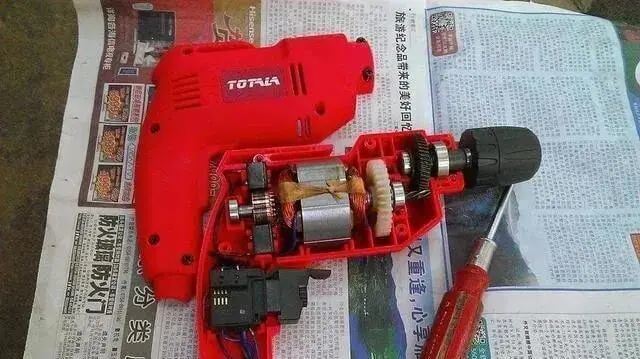Contenuto della pagina
AlternaPerché gli utensili elettrici generalmente utilizzano motori con spazzole anziché motori brushless??
Perché gli utensili elettrici (come trapani a mano, smerigliatrici angolari, eccetera.) generalmente utilizzano motori a spazzole invece di motori brushless? Capire, questo non è davvero chiaro in una frase o due.

Motori a corrente continua si dividono in motori a spazzole e motori brushless, e il “spazzola” qui menzionato si riferisce alle spazzole di carbone. Che aspetto ha una spazzola di carbone??

Perchè fare Motori a corrente continua servono spazzole di carbone? Qual è la differenza tra spazzole di carbone e senza spazzole di carbone?? Continuiamo a leggere!
Principio del motore a spazzole DC
Come mostrato in figura 1, questo è un modello di struttura del motore a spazzole DC. Due magneti anisotropi fissi, posto al centro di una bobina, le estremità della bobina erano collegate a due anelli semicircolari di rame, estremità dell'anello in rame e contatto fisso con spazzola in carbone, e poi le estremità della spazzola di carbone sono state collegate all'alimentazione CC.

Figura 1
Dopo aver collegato l'alimentazione, la corrente è quella indicata dalla freccia in Figura 1. Secondo la regola della mano sinistra, la bobina gialla è sottoposta ad una forza elettromagnetica verticale verso l'alto; la bobina blu è soggetta ad una forza elettromagnetica verticale verso il basso. Il rotore del motore inizia a ruotare in senso orario e successivamente 90 gradi di rotazione, come mostrato in figura 2.

Figura 2
In questo momento, la spazzola di carbone si trova proprio al centro dello spazio tra i due anelli di rame, e non c'è corrente nell'intero circuito della bobina. Ma sotto l'azione dell'inerzia, il rotore continua ancora a ruotare.

Figura 3
Quando il rotore gira nella posizione sopra indicata per inerzia, la corrente della bobina è mostrata in Figura 3. Secondo la regola della mano sinistra, la bobina blu è soggetta ad una forza elettromagnetica verticale verso l'alto; la bobina gialla è sottoposta ad una forza elettromagnetica verticale verso il basso. Il rotore del motore continua a ruotare in senso orario, Dopo 90 gradi, come mostrato in figura 4: in questo momento, la spazzola di carbone si trova proprio nello spazio centrale tra i due anelli di rame, e non c'è corrente nell'intero circuito della bobina. Ma sotto l'azione dell'inerzia, il rotore continua ancora a ruotare. Quindi si ripetono i passaggi precedenti, e il ciclo continua.
Motore CC senza spazzole
Come mostrato in figura 5, questo è un diagramma modello di una struttura di motore brushless CC. È costituito da uno statore e un rotore, dove il rotore ha una coppia di poli magnetici; lo statore è avvolto con molti set di bobine, nel diagramma sono mostrati sei gruppi di bobine.

Figura 5
Quando passiamo corrente alle bobine dello statore 2 E 5, le bobine 2 E 5 produrrà un campo magnetico, e lo statore è equivalente a una barra magnetica, Dove 2 è l'S (Sud) palo e 5 è poi (nord) palo. Poiché i poli dello stesso sesso si attraggono a vicenda, il polo N del rotore ruoterà verso la bobina 2 posizione e il polo S del rotore ruoterà verso la bobina 5 posizione, Figura 6.

Figura 6
Quindi ritiriamo la corrente dalle bobine dello statore 2 E 5 e passare la corrente alle bobine dello statore 3 E 6. In questo momento, bobine 3 E 6 produrrà un campo magnetico, e lo statore è equivalente a una barra magnetica, Dove 3 è l'S (Sud) palo e 6 è poi (nord) palo. Poiché i poli magnetici dello stesso sesso si attraggono a vicenda, il polo N del rotore ruoterà verso la bobina 3 posizione e il polo S del rotore ruoterà verso la bobina 6 posizione, Figura 7.

Figura 7
Allo stesso modo, quindi rimuovere la corrente dalle bobine dello statore 3 E 6, e poi passare la corrente alle bobine dello statore 4 E 1. In questo momento, bobine 4 E 1 produrrà un campo magnetico, e lo statore è equivalente a una barra magnetica, Dove 4 è l'S (Sud) palo e 1 è poi (nord) palo. Poiché i poli opposti si attraggono, il polo N del rotore ruoterà verso la bobina 4 posizione e il polo S del rotore ruoterà verso la bobina 1 posizione. Fino a
Fino a questo punto, il motore ha fatto mezzo giro …. Il secondo mezzo giro è lo stesso del principio precedente, quindi non lo ripeteremo qui. Possiamo semplicemente intendere il motore DC brushless come se fosse come pescare una carota davanti a un asino, in modo che l'asino continui a muoversi verso la carota.

Allora come possiamo passare la corrente esatta a bobine diverse in momenti diversi?? Ciò richiede un circuito di commutazione di corrente …… Non entrerò nei dettagli qui.
Confronto dei vantaggi e degli svantaggi del motore DC con spazzole e del motore DC senza spazzole
Motore a spazzole CC: avvio veloce, frenata tempestiva, regolazione regolare della velocità, controllo semplice, struttura semplice, economico. Il punto è che il prezzo è conveniente! Il prezzo è economico! Il prezzo è economico! E ha un'elevata corrente di avviamento, coppia elevata (forza rotante) a bassa velocità, e può trasportare carichi molto pesanti.
Tuttavia, a causa dell'attrito tra la spazzola di carbone e il commutatore, Il motore a spazzole DC è facile da produrre scintille, Calore, rumore, interferenze elettromagnetiche con l’ambiente esterno, e bassa efficienza e vita breve. Perché la spazzola di carbone è un prodotto soggetto ad usura, è facile fallire, e deve essere sostituito dopo un periodo di tempo.

Motore DC senza spazzole: perché il motore DC brushless elimina la spazzola di carbone, quindi il rumore è piccolo, nessuna manutenzione, basso tasso di fallimento, lunga durata, e il tempo di funzionamento e la tensione sono più stabili, affinché l'interferenza dell'apparecchiatura radio sia piccola. Ma è costoso! Costoso! Costoso!
Gli utensili elettrici sono strumenti molto comuni nella vita, e ci sono molti marchi diversi e una forte concorrenza, quindi le persone sono molto sensibili al prezzo. E gli utensili elettrici devono trasportare un carico molto pesante, deve esserci molta coppia iniziale, come il trapano a mano, trapano a percussione. Altrimenti, durante la foratura, il motore può facilmente non funzionare perché la punta del trapano è bloccata.

Immagina un motore DC a spazzole dal prezzo basso, coppia di spunto elevata e in grado di sopportare carichi pesanti; il motore brushless ha un basso tasso di guasto e una lunga durata, ma è costoso e la coppia di avviamento è molto inferiore a quella del motore a spazzole. Se scegli, come sceglierai, Penso che la risposta sia autoesplicativa.



